Menu
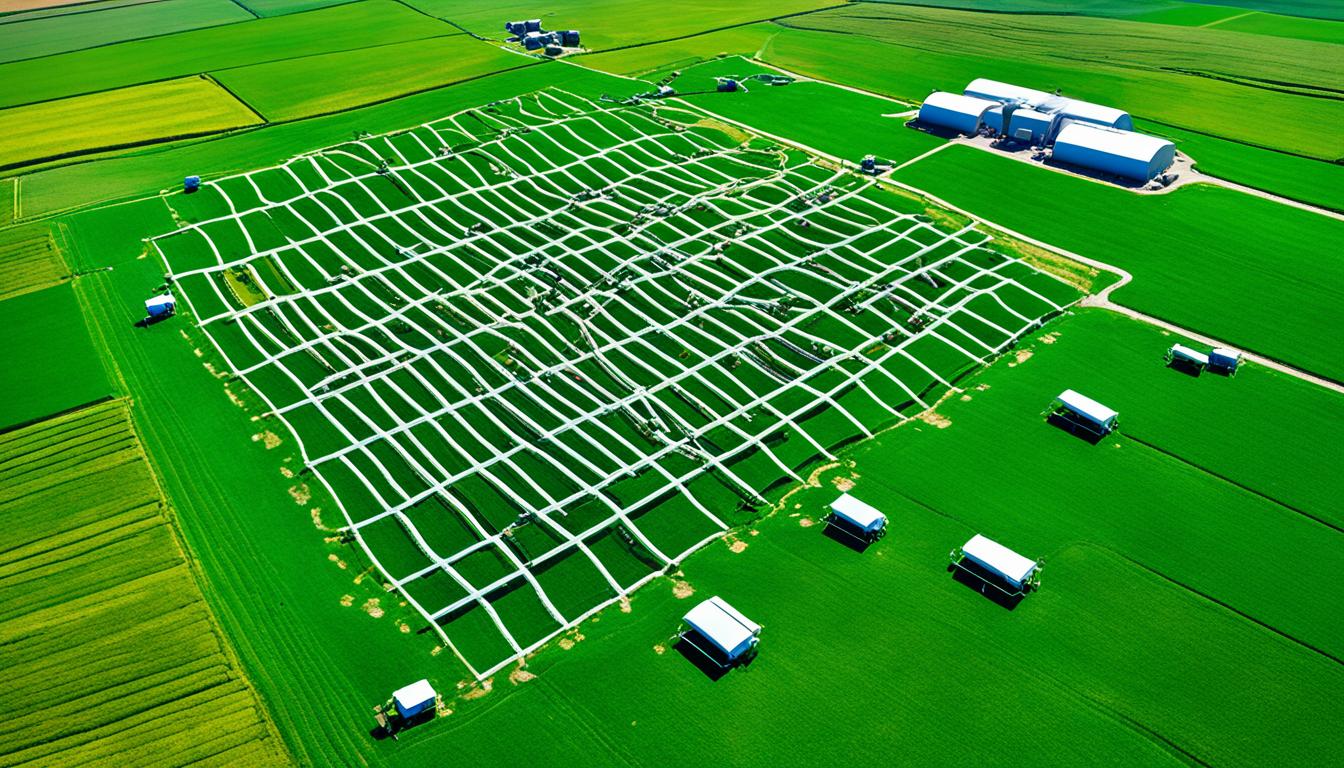
Remote monitoring can cut animal deaths by up to 35%. This way of managing animals is changing farms worldwide. Ranchbot’s high-tech solutions boost farm efficiency. They provide instant data for better animal care.
With deep industry knowledge, we help ranchers face many challenges. From keeping an eye on water levels to ensuring animals are safe. Our Texan-made tools do more than just track data. They help save resources and make farms last longer. This gives ranchers peace and better farms.
Welcome to a new farming era with high-tech remote monitoring for livestock. This system uses IoT sensors, telecom, and drones. It provides a *livestock tracking system* that boosts animal care and farm efficiency.
Our innovative ranch technology offers tools for real-time data and insights. IoT sensors can spot gases, check the temperature, and monitor livestock and the environment. They work with strong networks like 5G and GPS, ensuring quick and accurate data.
These *automated livestock monitoring* systems use sturdy IoT devices with specific sensors. Software creates easy-to-use apps for checking up on livestock and predicting issues. This blend of hardware and software is key to great farm management.
For bird’s-eye views, drones and satellites are essential. Drones watch the animals up close, while satellites map the farm from afar. Together, they give a full picture of the farm and its animals.
There’s also top-notch video surveillance to watch over the animals closely. This tech spots signs of stress or injury. It’s good at finding lost animals and keeping an eye out for thieves.
Video surveillance success depends on the area, camera quality, network, and memory. Keeping costs low and reliability high is crucial. This leads to farms that are both productive and sustainable.
But, not all farmers are quickly picking up these new methods. The nifty tech lowers work costs but can be tricky to set up. Problems sharing info between different tech can slow things down. This shows why teams with varied skills are important for farming tech progress.
Using automated livestock monitoring can greatly improve ranching. These systems track animals constantly, which boosts their care. This also makes managing resources more efficient and increases productivity.
Automated systems are key to better animal welfare. They provide immediate data on an animal’s health and behaviour. This helps spot diseases early, so we can act fast to keep animals healthy.
By watching vital signs and the environment closely, we create the best spaces for our animals. This makes them happier and more productive.
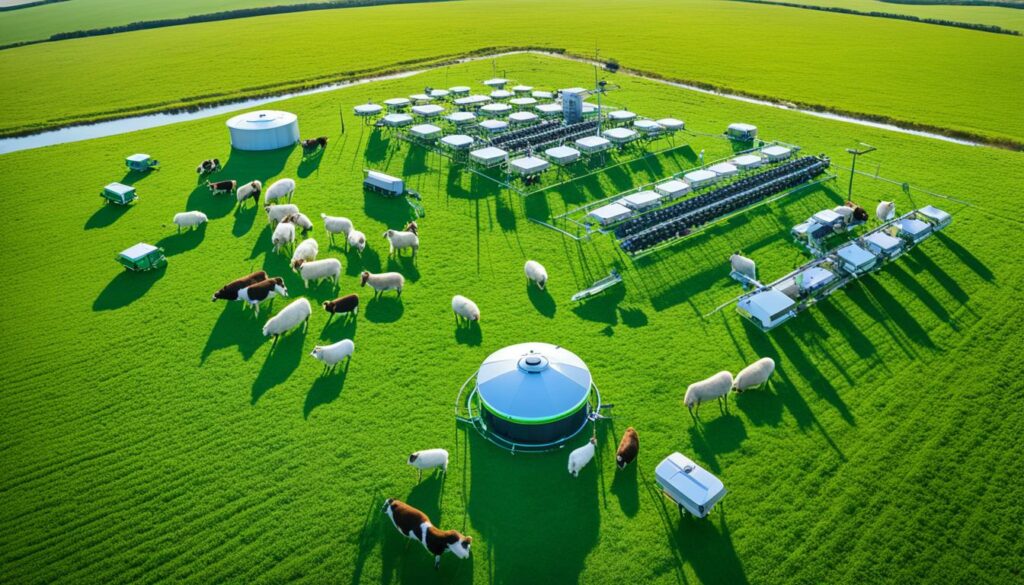
One huge plus of automated monitoring is better resource use. It helps with keeping an eye on how much animals eat and drink, and their living conditions. These details are key for smart and sustainable farming.
For example, tools that automatically feed or water animals can be set to each animal’s needs. This cuts down on wasted resources and saves money. Systems for climate control and cleaning make animals more comfortable and healthier. This, in turn, helps them grow better and produce more.
These tech-based benefits improve the overall running of a farm. They prepare us to face the challenges of a growing world population. As farming changes, using new technology is vital to keep up and be sustainable.
Wireless livestock monitoring is a brand-new way for farmers to keep an eye on their animals. It uses smart sensors and a network connection. This makes it easier to gather and understand data about the animals. It was first developed by researchers at Carnegie Mellon University and Virginia Tech with help from an NSF grant.
The system uses a special 5 cm sensor ear tag. This tag tracks things like how an animal moves, its health, and where it is. It works well because it doesn’t use a lot of power. This is different from WiFi or ZigBee. Those need a lot of power and can’t work over long distances. But, with this system, you can check on the animals from far away without using too much energy. This means you can keep an eye on the animals without being close to them all the time.
The WiTEch Lab at Carnegie Mellon, led by Swarun Kumar, is a big part of this work. They’ve found many ways to use this technology, not just for watching animals. Their work shows how useful and flexible this tech can be. It’s making farming better and more efficient, even when many devices are being used at the same time.
One great tool using this technology is the Reporter sensor module by Crodeon. It can measure and watch the animals all day and night. It connects to up to four sensors and sends data through a strong 4G signal. This makes sure you can track your livestock easily and without too much fuss. Plus, it can work with solar energy, making it even easier to set up and use.
The part everyone loves? It’s easy to look at the data. The system has a simple, clear screen where you can see graphs and get alerts if something’s not right. You can set it to warn you about things like too much heat, bad air, or not enough water. This is how this system meets all sorts of needs and really helps with taking care of the animals.
| Technology | Purpose | Advantages |
|---|---|---|
| 5 cm Sensor Ear Tag | Monitor biometrics, acceleration, location | No need for recharging or replacement |
| LP-WAN | Enable remote monitoring over long distances | Low data rate, energy-efficient |
| Crodeon’s Reporter | Live measurements, 24/7 monitoring | User-friendly, continuous power options |
| 4G Data Transmission | Reliable connection for sensor data | Supports customisable alarms and detailed graphs |
IoT livestock monitoring systems are changing modern farming. They use the latest tech to give amazing insights and control over how we manage our animals. By using sensors and IoT gateways, farmers can get and analyse immediate data on how their animals are doing and the environment they live in. This makes things run better and keeps the animals safer.
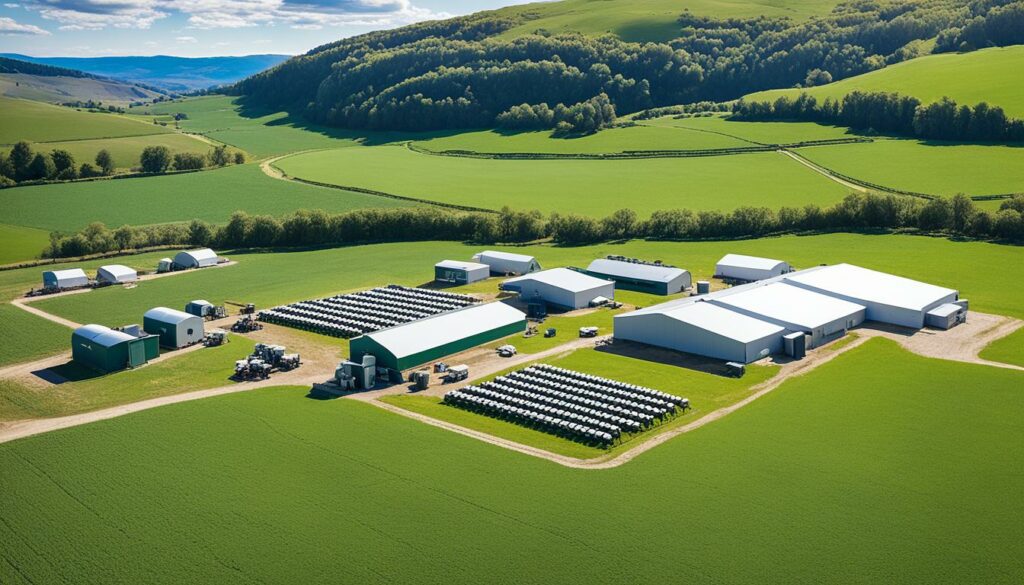
In looking after livestock, 51% of the market is filled by hardware and systems technology like sensors. These sensors, a key part of IoT livestock monitoring, track things like how warm it is, how wet the air is, and how much the animals are moving. Companies like Streamline are aiming to put 400,000 special devices everywhere by 2024. These devices will make sure there’s always a connection, letting farmers use real-time data anywhere, anytime. The plan is to have 7 million of these devices worldwide, making real-time data analytics a standard practice.
The data these systems collect can help forecast things like when animals might get sick or how big they will grow. IoT gateways are key for this predictive work. They link up the sensor data with the internet, making it possible to watch how much the animals are eating or if there’s enough water for them to drink. Also, IoT gateways can do some of the thinking right where the animals are, without needing to be online all the time. This kind of local thinking can pick up on issues like if an animal is stressed or acting strangely, and steps can be taken right away to help.
Streamline and others are working hard to make devices that do more for less. As more businesses see the value in this kind of technology, the industry is set to grow a lot, up to USD 11.18 billion by 2029. With this growth, the need for deep, immediate, and predictive insights will only get stronger.
Using real-time livestock monitoring can greatly boost productivity. In 2016, 51% of the market was held by sensors. These sensors help by giving instant updates on an animal’s health and status.
The IoT sector is growing fast, expected to increase by 12.1% from 2022 to 2029. By 2029, the market for managing livestock will be worth USD 11.18 billion. This shows how important technology is for making farming more efficient.
AI is also changing how we work with animals. It’s now used to watch animal behaviour, catch early signs of sickness, and find problems in the animals’ environment. This new way of working helps animals to be less stressed and farms to be more efficient. Wearable sensors and computer vision are used a lot to gather data about the animals.
Farmers should focus on five key steps to make the most of these improvements. They are: collecting data, moving that data to where it’s needed, storing the data, analysing it, and sharing the results. These steps help information flow smoothly and improve farm operations.
With the world’s population expected to hit 9.15 billion by 2050, increasing farm productivity is critical. Using advanced sensors and other tech can help meet the future’s big demands. It’s crucial for keeping track of and managing livestock effectively.
Satellite livestock tracking has changed how farms are managed. It offers wide farm coverage, even in remote areas. This high-tech monitoring reaches every animal, no matter where they are. 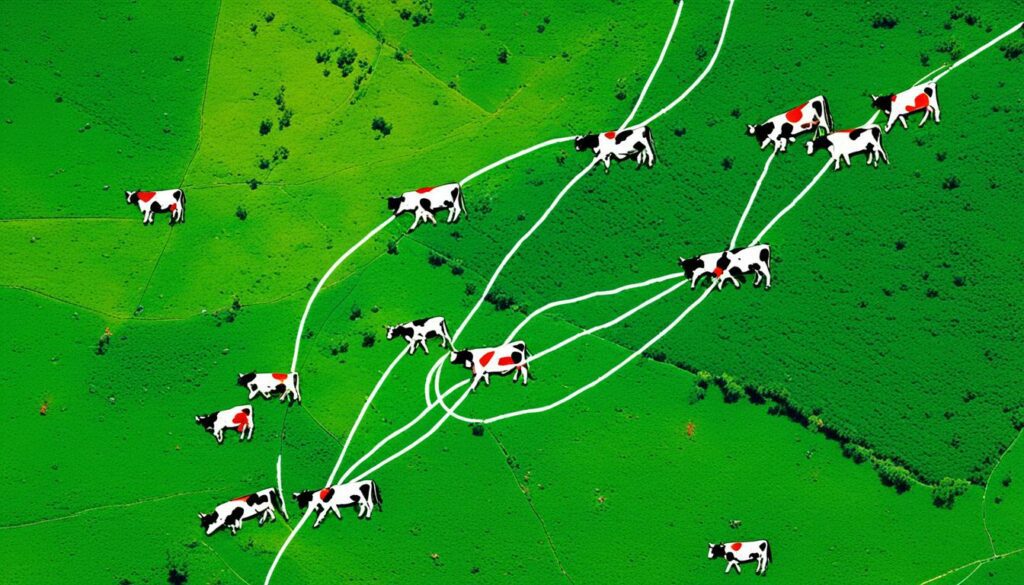
Streamline is big in the market, watching over 7.95 million livestock in South Africa. By 2024, they plan to use 400,000 5G NB-IoT devices to improve satellite livestock tracking. They want to use 7 million devices worldwide soon, showing the technology’s growing popularity.
Sateliot’s approach is both cost-effective and efficient, unlike older satellite systems. This has made them a top choice for farms worldwide to get advanced monitoring technology.
The Livestock Phenomics Platform has made big steps in improving efficiency (Animal Production Science, 2016). Using real-time sensors, smart animal farming has proven to boost animal health and output (Annual Review of Animal Biosciences, 2019). For example, technology like Ear Tag Automated Activity Monitors helps better predict when dairy cows are ready for breeding (Theriogenology, 2020).
Let’s look deeper into the benefits:
| Key Statistic | Impact |
|---|---|
| Streamline’s Current Market | 7.95 million livestock in South Africa |
| 2024 Deployment Goal | 400,000 cellular 5G NB-IoT livestock devices |
| Global Device Target | 7 million devices worldwide |
| Cost Efficiency | Sateliot’s solution more affordable and efficient |
Studies like “Individual Dairy Cow Management” have made great progress, despite the challenges (Journal of Dairy Research, 2020). And the use of tech has helped agriculture and food systems move towards sustainability (Information Processing in Agriculture, 2018). All these steps back our aim of using advanced monitoring technology for full farm coverage.
Remote animal health monitoring technologies have transformed how we look after livestock. They make it easier to spot and deal with health issues quickly. Features like heat detection accuracy and eating and rumination patterns are crucial. They help keep animals healthy.
Detecting when animals are in heat is important. It tells us about their reproductive cycles and lets us act fast. High-tech sensors ensure accurate heat detection. This leads to better breeding results. Tracking body temperature helps farmers know exactly when animals are fertile. This makes breeding more effective and reduces delays.
Watching what animals eat and how they chew helps check their health. Changes in eating or chewing can point to problems. Having constant eating data can help find issues early. This allows for quick fixes. Better eating habits mean animals digest food well. This improves how they use food and their overall work.
A study at the 2022 5th Artificial Intelligence and Cloud Computing Conference praised IoT and smart tools for managing herds. John Io Ojo and Chunling Tu were among the respected authors. They showed how IoT sensors track what animals do. This gives clear and ongoing health signs for better remote health checks.
Using these high-tech tools shows why accurate heat and diet monitoring are key to keeping animals well. Farming becomes more productive, animals are happier, and the farm runs smoother. By adopting these new tools, farmers can see a big difference in their work.
The livestock monitoring market is booming. It was worth USD 1.6 billion in 2022 and is expected to hit USD 3.7 billion by 2030. At an 11.0% growth rate, it’s a key area of modern farming. Let’s look at the best remote tracking solutions available now.
Several companies are leading the way in livestock tech. They include Allflex, DeLaval, Afimilk Ltd., Nedap N.V., and BouMatic. These names are well-known for their innovative tools. Their tech helps improve productivity and care for animals.
The growing global meat demand and efficiency gains from advanced tech are spurring market growth. This area is seeing a surge in smart tags, sensors, and GPS devices. They offer accurate tracking, crucial for managing large numbers of animals.
Farms for dairy, poultry, and swine are on the rise all over the world. The need for smart feeding solutions is growing fast. This trend highlights the importance of managing resources efficiently.
By 2030, Europe is predicted to lead in livestock monitoring advancements. It shows a strong commitment to using the latest tech in agriculture. This approach boosts productivity and environmental care.
| Company | Key Contribution | Region |
|---|---|---|
| Allflex | Advanced ear tags and monitoring devices | Global |
| DeLaval | Innovative dairy solutions | Global |
| Afimilk Ltd. | Milking and herd management systems | Global |
| Nedap N.V. | Electronic identification and automation | Global |
| BouMatic | Robotic milking and herd management | Global |
Also, new companies like Brainwired, Dilepix, Smart Paddock, FarmSee, and Transport Genie are making their mark. For example, Smart Paddock from Australia offers smart ear tags for tracking. Brainwired, from India, created WeStock for keeping an eye on animal health. These new solutions are changing the market fast.
In short, the livestock monitoring sector is filled with both leaders and innovators. Their work is key to sustainable farming. The growth in new tech shows that these solutions are vital for the industry’s future.
We understand that each farm is unique. That’s why we offer customisable livestock solutions. These solutions are tailored to meet the needs of every ranch. With personalised ranch monitoring, farmers can tackle their specific issues. This helps their operation run better and more efficiently.
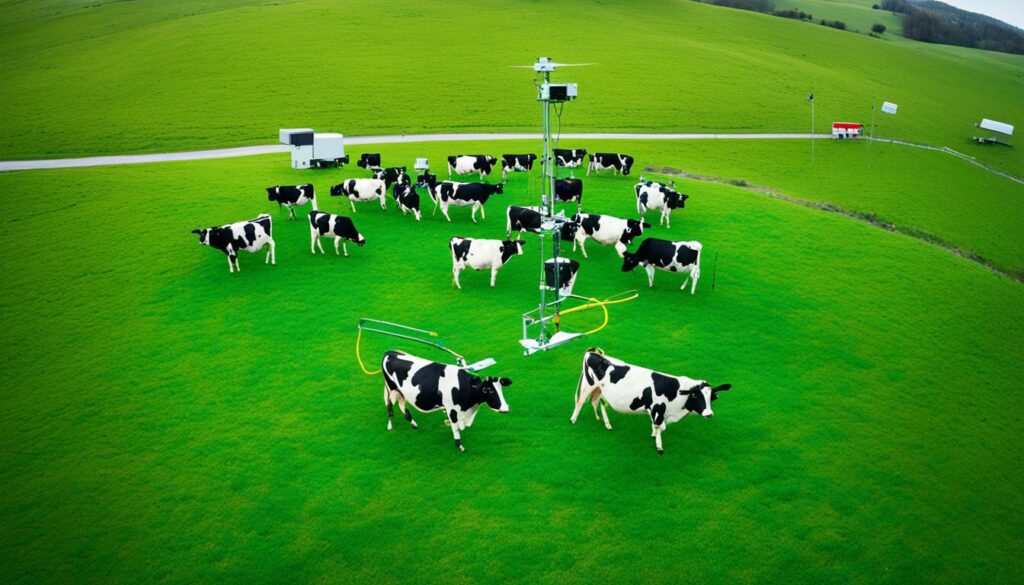
Our RanchMaster system is designed for flexibility. It includes a weather station that tracks important data. This weather data helps in monitoring livestock from far away. Unlike other weather solutions, RanchMaster isn’t expensive and offers complete automation. It comes with a wireless base station and can be expanded with additional features.
It also keeps track of soil moisture, which is key for watering and improving crops. Moisture levels in soil can be different across a farm. This means monitoring at multiple spots is very important. The irrigation system by Ranch Systems makes watering more efficient. It saves money by using water better and cutting down on manual work.
But that’s not all RanchMaster does. It also keeps an eye on engines and controls them from afar. This lets you know how the engines are doing in real time. It saves money on labour and energy by managing pump use better.
Software is a big part of making farms work well. Chetu offers AI software that helps manage things like feed and inventory. This software makes sure everything runs smoothly. It covers things like planning feed and reordering supplies. This is all connected in one central system for easy control and analysis.
Chetu also provides software for tracking livestock and their breeding lines. It keeps important information safe in the cloud. Their Automated Weighing System makes weighing animals easy and fast. This helps farmers make better choices that keep animals healthy.
Using these tailored farming systems makes farms more efficient. It also helps in meeting standards from regulatory bodies. These include the USDA, FDA, and more. By meeting these high standards, farms can be both productive and eco-friendly.
Remote livestock monitoring, powered by IoT, has changed how farms are run. It’s proven by real-life examples. A case study in J. Dairy Res. (2020) showed using sensors can help small animals. It improved their health and happiness. Farmers saw better animal care and more crops thanks to smart tech.
Ear tag monitors, in Theriogenology (2020), are great for knowing when dairy animals are ready to mate. This not only makes mating more successful but also boosts crop yields.
Another study in Sensors (2019) talked about using IoT for smart farming. It notices health issues earlier and keeps animals happier. For example, changes in a cow’s activity can tell us if it’s sick. This way, we prevent bigger health problems.
A report by Educational Administration: Theory and Practice (2024) highlighted how IoT helps. It uses sensors and tags to watch animals closely. This saves money and makes the data we collect more accurate.
There’s also research in Anim. Prod. Sci. (2016) that shows how special technology for animals can make farms better. Inventing ultrawide bandwidth helped too, as shown in Proc. IEEE (2009). It makes tracking animals easier.
All this shows using advanced tech to watch animals makes farms run better. Remote monitoring is very effective.
When we look at different ways to track livestock, we see options like drones and ground sensors. They each have their strengths and weaknesses. Let’s take a closer look at what they offer.
Drones are great for getting a bird’s-eye view of the farm. They cover a lot of ground, making them ideal for checking on animals in vast pastures. This is especially useful for monitoring free-range livestock.
Ground sensors give us up-close details on how animals are doing. They track things like where animals move and their health. They are key in spotting illnesses early. For example, they’ve been really helpful in watching over beef cattle and catching health issues in dairy cows.
Using either of these systems can help make farming more eco-friendly. Choosing between them depends on things like farm size, what kind of monitoring you need, and your budget. Studies have found that using these technologies to manage grazing can also help the soil by cutting down on erosion.
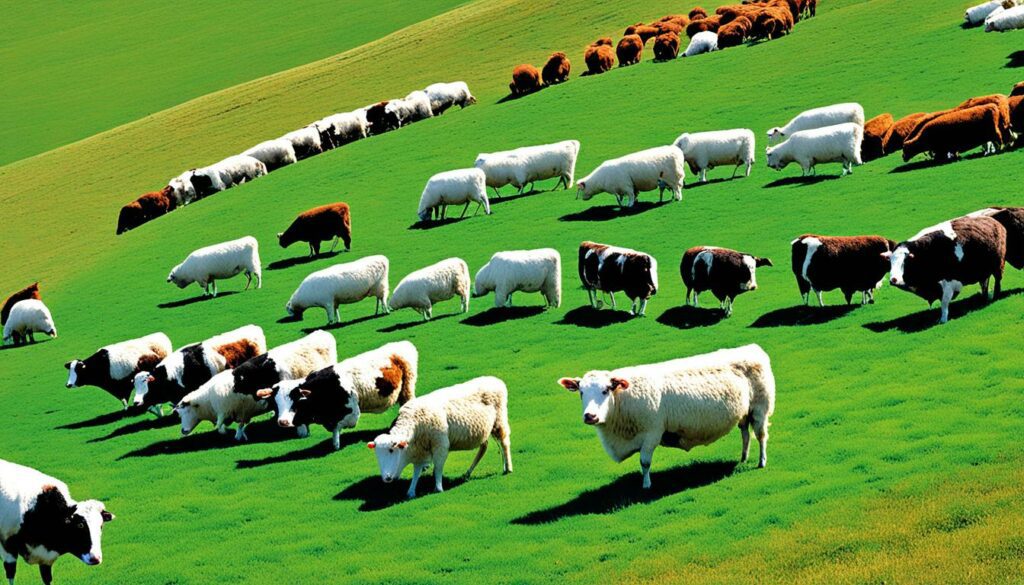
When looking at wearables for animals, we often look at neck collars and leg sensors. Neck collars track how much an animal eats, chews its cud, and moves. They’ve proven really useful for keeping an eye on cows on dairy farms.
Leg sensors can tell if an animal is walking strangely, showing possible lameness. This tech has really improved, making it better at finding when animals need help. It’s a big step for animal welfare.
Research by Maroto-Molina and team (2019) highlights that cheap, smart systems can be a game-changer for watching over herds from a distance. When deciding on a system, think about what health or movement signs are most important for your animals. For example, neck collars might notice health problems that leg sensors can’t.
The best choice depends on the farm’s conditions and what the animals need. By using the right tech in the right way, we can improve animal health and how our farms work. This leads to better farming that’s good for the environment and the animals.
The way we manage livestock is changing fast because of new tech. Next-gen farming will rely on AI and machine learning heavily. This means we’ll use more advanced tech in the fields.
Remote monitoring systems are making a big impact. They keep an eye on critical areas like what the Cynomys Livestock System does. It watches over 30 important parts, helping farmers work better and spot health issues early.
We looked at 1,454 new companies worldwide and found 20 of the best. These startups are all about the latest tech in farming. The US and UK are very active in this. They’re using AI, drones, the cloud, and blockchain to make farms more efficient.
Companies like PharmRobotics and myAnIML are leading with new ideas. PharmRobotics built a robot that gives out animal medicine accurately. myAnIML uses AI to predict when cattle might get sick. Animals.ai also uses AI to make sure animals are doing well. It’s really changing how we look after livestock.
New farming tech is bringing in a new era. It’s all about getting better, not just bigger. With these tools, farmers can be more exact, learn more, and run their farms really well.
One of the big challenges in remote livestock monitoring is handling security, staying connected, and dealing with a lot of data. The Cynomys Livestock System (CLS) helps by tracking over 30 important stats. It’s a big step forward in watching over animals from afar.
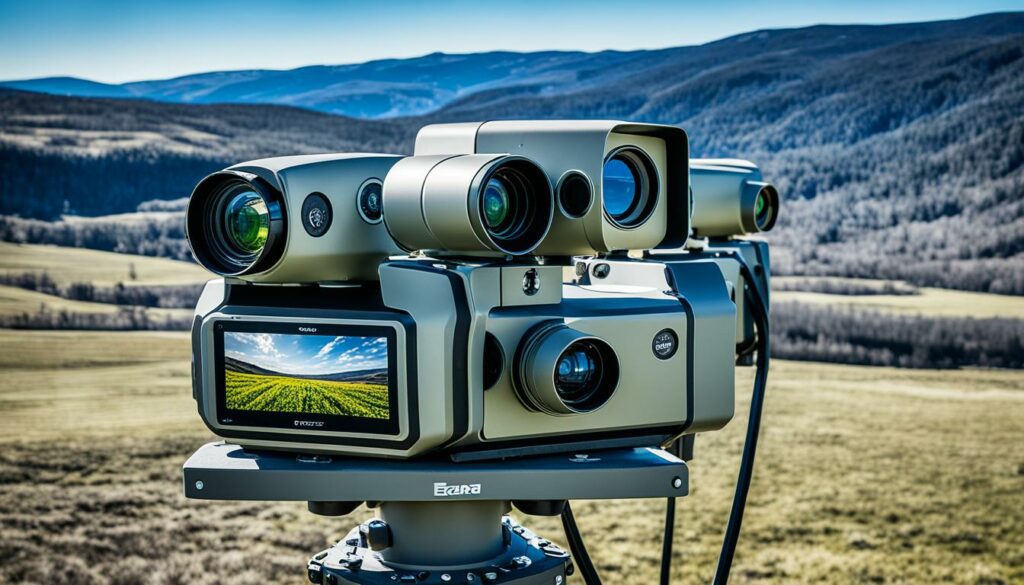
Getting data live on what and how much animals eat, and how fast they grow helps farmers. It lets them adjust feeding and breeding to be better. But, there are still big hurdles like not always having enough power and mixing different tech together that must be cleared for success.
Solutions to livestock tracking issues get a boost by constantly watching how animals are doing. This can catch health problems early, cutting down on illness costs and making animals better off. Also, watching feed schedules and herds from afar makes farming kinder to the environment.
More and more people are keen on using high tech for keeping check on animals raised on open spaces. This is according to a study by Stampa E., Schipmann-Schwarze C., and Hamm U. (2020).
Remote monitoring isn’t just handy; it’s priceless. Combining it with controlled grazing, as seen in research by Yu H. et al. (2019), can lessen damage to the land. It hints at a greener future.
Yet, keeping data safe and connecting everything up is still tough. Making strong, data-hungry systems work in farming is a challenge. We need better tech and fresh ideas to keep moving forward in the field.
| Challenges | Solutions |
|---|---|
| Connectivity Issues | Implementing robust network solutions |
| Data Security | Ensuring encrypted data transmission |
| Power Supply | Deploying renewable energy sources |
| System Integration | Using compatible hardware and software |
In the end, beating the tech barriers in farming and finding good solutions to livestock tracking issues are key. These steps are what will make remote monitoring a sustainable and effective way to farm in the future.
Using advanced monitoring for livestock is key for better farming today. For beef cattle, it means more profits and less cost. These systems help watch over the health, actions, and use of resources by the animals. This lets farmers do better and make their farms more productive.
Precision tools like GPS and drones help track cattle, check health, and see how they eat in fields. They cut down on waste, save resources, and reduce harmful gases. This makes the cattle industry more sustainable. Also, smart ear tags give instant updates on the animals. This is good for spotting diseases early and managing the herd well.
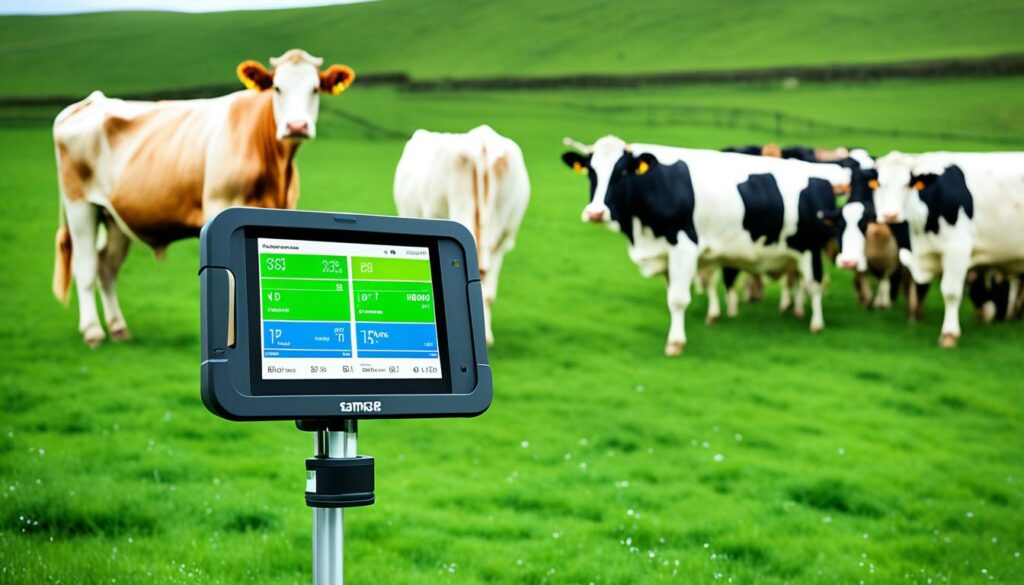
AI is making a big change in how efficient farms can be. It can see when diseases might spread, watch growth, and improve food timings. This makes sure that animals are looked after well. Better breeding also helps, by offering quicker growth and beef that’s more disease-resistant and of better quality.
Feeding and watering systems are now automated to give exactly what each animal needs. This helps them grow better and stay healthier. Apps like HerdView® make managing a farm easier. They keep track of animals and supplies. This helps make better choices on the farm.
IoT uses wearables to check on animals’ health, like blood pressure and temperature. This is key for spotting sickness early and avoiding high vet costs.
LoRaWAN trackers are improving how we watch over animals’ locations and keep them safe. They work with analytics and the cloud to get data fast for smart decisions. These methods together help farms work better and in a more eco-friendly way.
Choosing to monitor livestock remotely is a big step into the future for farming. It relies on technology like IoT sensors, drones, and satellites. These tools help us work more efficiently and care better for our animals. They bring us to a new era where old farming ways mix with hi-tech for better results.
Using tech like IoT sensors and data tools has many pluses. It helps us predict and manage things better, even when the internet or power isn’t so reliable. While it may cost to start with devices and systems like drones and video cameras, it pays off in the way we work and our farm’s output. Video surveillance, for example, lets us watch over things with little human help. And it’s made smarter by machine learning and advanced image reading, giving us deep insights into our farms.
The future of farming will keep moving with new smart ways to manage farms. Remote monitoring is key for a sustainable, tech-filled farming tomorrow. To learn more about the latest studies and developments, check out this comprehensive source. These efforts aim for more productivity, better animal care, and sustainable farming practices.
Advanced remote livestock monitoring has several benefits. It improves animal welfare by constantly checking their health. It also helps manage resources better for sustainable farming.
Additionally, it gives real-time updates on the health and productivity of livestock. This makes things run smoother for farmers.
Livestock tracking systems boost ranch management by updating data on where animals are, their health, and how they act in real time. This tech lets ranchers make smart choices to boost productivity and keep their livestock happy.
It also helps streamline operations.
Automated monitoring of livestock offers many plusses. It constantly checks on the animals’ health and safety. It also uses resources efficiently, making ranches both more green and cost-effective.
This results in higher productivity and profit for farmers.
Wireless monitoring systems use sensors and networks to gather and study animal data. This setup allows producers to look after their livestock well through efficient monitoring.
It does all this without the limits of traditional methods.
The Internet of Things (IoT) is key to livestock monitoring systems. It gathers real-time data and uses predictive analysis.
This helps predict and tackle problems early, giving farmers useful insights for better decisions.
Real-time monitoring upgrades productivity by allowing farmers to check their animals’ health instantly. This quick check means farms run more efficiently, leading to better outcomes and sustainability.
Satellite tracking watches over large farm areas effectively, regardless of size or location. It overcomes distance and barriers, offering a strong solution for far-off farms.
This makes it easier to keep an eye on every part of the farm.
Remote animal health monitoring needs accurate heat detection and tracking eating habits. These are important for spotting health issues quickly, letting farmers step in fast to keep animals well.
The market has many high-quality remote monitoring solutions. They are praised for being precise, reliable, and having a full set of tools for managing livestock and their health.
Customisable solutions meet each ranch’s unique needs. They help farmers do better by tailoring to the farm’s specific situation. This boosts efficiency and productivity all round.
Real-world cases show how effective remote monitoring can be. They give solid examples of tech improving both how farms are run and the welfare of the animals.
Drones cover more ground from the air, offering a broad view and flexibility. Ground sensors, however, collect detailed data up close but face natural obstacles. The best choice depends on the farm’s needs and its layout.
Neck collars track location and activity but are big for smaller animals. Leg sensors give detailed movement data and are good for studying how animals walk. Both have their strengths and weaknesses, based on the animal and what you’re monitoring.
Remote tech will see more AI and machine learning, making systems smarter. This will offer farmers more insights and control, heralding a new age of precise farming.
Setting these systems up can be tough due to issues like connecting to the internet, power supply, and making all the tech work together. But new ideas and progress help overcome these to make the systems work well on farms.
Complete monitoring gives a full view of livestock health and how resources are used. With detailed data, farmers can improve how they manage their farms, making them more efficient, productive, and profitable.